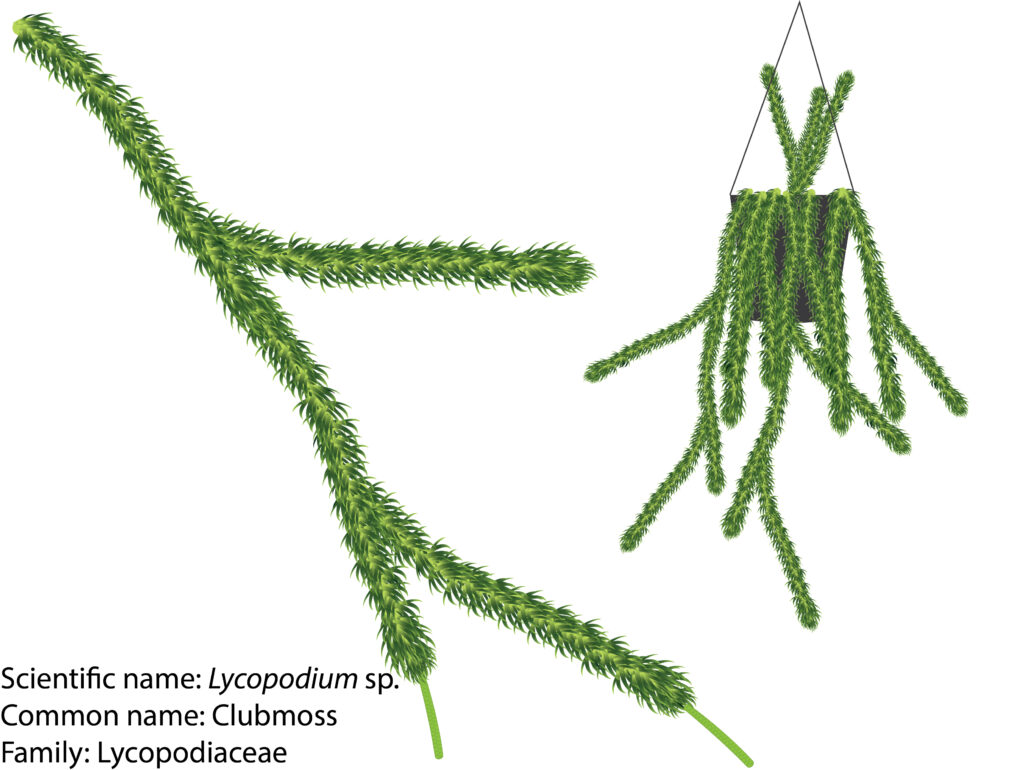Clubmoss, belonging to the family Lycopodiaceae, is widespread in moist regions around the world. With over one hundred species in this genus, these plants are ancient and have ancestors that dominated the world’s vegetation approximately 250 million years ago, along with the ancestors of horsetails (Equisetum). They are considered more primitive than ferns but more advanced than mosses. Clubmosses vary in size, ranging from tiny thread-stemmed plants found in boggy areas below heath, to large epiphytes that create curtains of fern-like foliage on the branches of tropical rainforest trees. The genus Lycopodium consists of 46 species, and it is found in North America, Europe, and many other countries around the world.
All club mosses share similar cord-like stems covered with overlapping, bright green or golden-green scale-like leaves. They are epiphytic plants that typically hang down with their roots only at the base. They form branches up to 20 centimeters long and have dichotomously branched structures. The leaves are small and herbaceous, measuring around 2 to 3 millimeters in length and 1.2 to 1.5 millimeters in width. The leaves have an ovate outline when flattened but appear falcate with both sides of the blade curving backward at the midrib. They are short-petiolate and decurrent. Club mosses do not produce flowers; instead, they bear tiny spore capsules nestled between the scales of delicate cones known as strobili.
Only the epiphytic species of club mosses are cultivated to a significant extent, primarily by fern enthusiasts. In tropical regions, they thrive in partially shaded areas with a consistently moist environment, often nestled in the forks of trees. In other regions, they require a greenhouse or conservatory with high humidity and can make striking specimens in hanging baskets. It is important to provide some air movement around them and avoid excessive water around the roots. Club mosses can be propagated through cuttings or by layering fertile stem tips.
Lycopodium clavatum:
Commonly known as clubfoot moss or foxtail, Lycopodium clavatum is a pteridophyte found in tropical or subtropical regions and in many European countries. It thrives in various habitats such as high altitudes, highlands, and grassy areas. The leaves of Lycopodium clavatum are small, measuring about 3 to 5 millimeters in length and 1 millimeter in width.
Lycopodium phlegmaria:
It is also known as the layered tassel fern, is an elegant species that is widely distributed in the rainforests of tropical Asia and the South Pacific. It is characterized by small, shiny, lacquered leaves that grow in four rows along the long, pendent stems. In this species and many related ones, the ends of the stems branch into groups of fine, elongated green tassels resembling strobili, which gives them the name “tassel ferns.” Lycopodium phlegmaria forms large clumps of hanging stems, making it well-suited for basket culture.
Clubmosses are commonly cultivated as ornamentals, both indoors and outdoors, due to their delicate beauty and graceful appearance. For example, Lycopodium volubile, a forest species, is often used as a table decoration after being collected. Many clubmoss species are popularly known as “Christmas green” and are frequently used in Christmas wreaths.
Clubmosses have also been used in homeopathy for the treatment of various conditions such as cough, aneurysms, constipation, fever, and chronic lung and bronchial disorders. They are believed to reduce gastric inflammations, aid digestion, and assist in the treatment of chronic kidney disorders.
To date, 132 compounds have been isolated and identified from clubmosses. The alkaloids of Lycopodium, including major alkaloids like clavatine and clavatoxine, as well as polyphenolic acids such as dihydrocaffeic and triterpenes, are of great importance due to their biological properties. Clubmosses also contain other compounds such as vanillic acid, coumaric acid, ferulic acid, syringic acid, huperzine A, lycopodine, lycoflexine, Alpha-onocerin, and sporopollenin.

Further reading:
Chen, Y., Yang, Q., & Zhang, Y. (2020). Lycopodium japonicum: a comprehensive review on its phytochemicals and biological activities. Arabian Journal of Chemistry, 13(5), 5438-5450.
Kitajima, M., & Takayama, H. (2012). Lycopodium alkaloids: isolation and asymmetric synthesis. Alkaloid synthesis, 1-31.
Siengalewicz, P., Mulzer, J., & Rinner, U. (2013). Lycopodium alkaloids–synthetic highlights and recent developments. The Alkaloids: Chemistry and Biology, 72, 1-151.
Wang, B., Guan, C., & Fu, Q. (2021). The traditional uses, secondary metabolites, and pharmacology of Lycopodium species. Phytochemistry Reviews, 1-79.
Wilson, L. R. (1934). The spores of the genus Lycopodium in the United States and Canada. Rhodora, 36(421), 13-19.